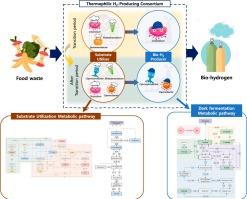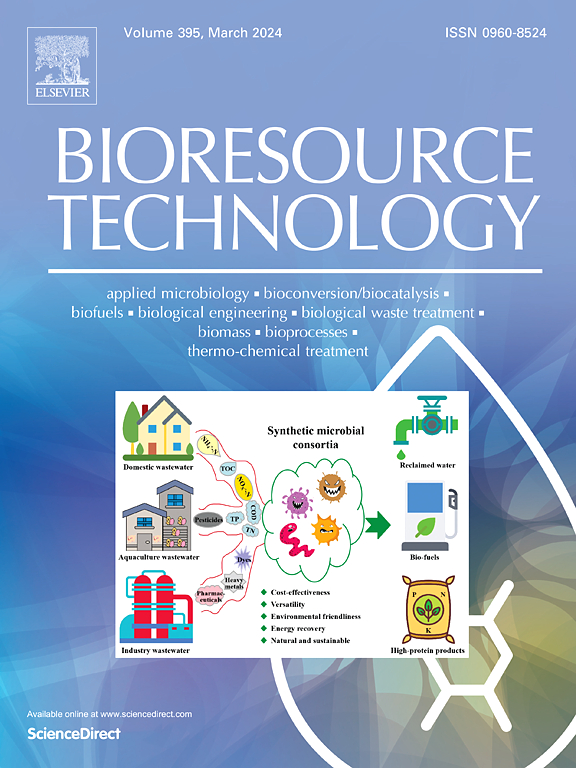利用厨余暗色发酵进行嗜热制氢的细菌协同作用和接力。
IF 9.7
1区 环境科学与生态学
Q1 AGRICULTURAL ENGINEERING
引用次数: 0
摘要
背景:食物垃圾是一个重大的全球性问题,每年产生 13 亿吨,预计到 2030 年将增至 21 亿吨。填埋和焚烧等传统处理方法带来了甲烷排放和污染等环境挑战。通过暗发酵制氢是一种可持续的替代方法,既能进行废物管理,又能产生可再生能源。目的:本研究的主要目的是分析食物垃圾嗜热制氢过程中的代谢途径和功能基因预测动态,重点研究细菌联合体在提高氢气产量中的作用:方法:以厨余垃圾为底物,嗜热细菌群为接种物,运行连续搅拌罐反应器(CSTR)。该研究利用基因组分析监测细菌生物群组成随时间的变化,并将这些变化与 H2 产量联系起来。利用气相色谱法和高效液相色谱法分析了挥发性脂肪酸(VFAs)和 H2 产率。利用京都基因和基因组百科全书(KEGG)数据库确定了参与发酵过程的功能基因:研究发现了一些关键的细菌物种,包括 Caproiciproducens 和 Caproicibacter,它们在 H2 生产的后期阶段占据主导地位,取代了梭状芽孢杆菌等早期的优势物种。这些细菌优势的转变与持续的 H2 产率密切相关,产率从 353 到 403 mL-L-1-h-1,H2 浓度在 55 % 到 62 %(v/v)之间。功能基因分析揭示了与多糖降解、糖酵解和暗发酵相关的重要途径:本研究强调了在嗜热条件下,细菌协同作用和接力在维持食物垃圾持续产生 H2 方面的重要性。研究结果为优化生物制氢过程提供了见解,强调了特定细菌物种在提高效率方面的作用。这些结果有助于制定可持续废物管理战略和可再生能源生产。本文章由计算机程序翻译,如有差异,请以英文原文为准。

Bacterial synergy and relay for thermophilic hydrogen production through dark fermentation using food waste
Background
Food waste is a significant global issue, with 1.3 billion tons generated annually, a figure expected to rise to 2.1 billion tons by 2030. Conventional disposal methods, such as landfilling and incineration, present environmental challenges, including methane emissions and pollution. Hydrogen production through dark fermentation presents a sustainable alternative, offering both waste management and renewable energy generation. This study investigates the bacterial synergy and relay mechanisms involved in thermophilic H2 production using food waste as a substrate.
Purpose
The primary aim of this research was to analyze the metabolic pathways and dynamics of functional genes prediction during thermophilic H2 production from food waste, focusing on the role of bacterial consortia in enhancing H2 yields.
Methods
A continuous stirred-tank reactor (CSTR) was operated using food waste as the substrate and a thermophilic bacterial consortium as the inoculum. The study utilized genomic analysis to monitor changes in bacteriobiome composition over time and to correlate these changes with H2 production. Volatile fatty acids (VFAs) and H2 production rates were analyzed using gas chromatography and high-performance liquid chromatography (HPLC). The Kyoto Encyclopedia of Genes and Genomes (KEGG) database was employed to identify functional genes involved in the fermentation process.
Results
The study identified key bacterial species, including Caproiciproducens and Caproicibacter, that dominated during the later stages of H2 production, replacing earlier dominant species such as Clostridium. These shifts in bacterial dominance were strongly correlated with sustained H2 production rates ranging from 353 to 403 mL·L−1·h−1, with H2 concentrations between 55 % and 62 % (v/v). Functional gene analysis revealed significant pathways related to polysaccharide degradation, glycolysis, and dark fermentation.
Conclusions
This study highlights the importance of bacterial synergy and relay in maintaining continuous H2 production from food waste under thermophilic conditions. The findings provide insights into optimizing biohydrogen production processes, emphasizing the role of specific bacterial species in enhancing efficiency. These results contribute to the development of sustainable waste management strategies and renewable energy production.
求助全文
通过发布文献求助,成功后即可免费获取论文全文。
去求助
来源期刊

Bioresource Technology
工程技术-能源与燃料
CiteScore
20.80
自引率
19.30%
发文量
2013
审稿时长
12 days
期刊介绍:
Bioresource Technology publishes original articles, review articles, case studies, and short communications covering the fundamentals, applications, and management of bioresource technology. The journal seeks to advance and disseminate knowledge across various areas related to biomass, biological waste treatment, bioenergy, biotransformations, bioresource systems analysis, and associated conversion or production technologies.
Topics include:
• Biofuels: liquid and gaseous biofuels production, modeling and economics
• Bioprocesses and bioproducts: biocatalysis and fermentations
• Biomass and feedstocks utilization: bioconversion of agro-industrial residues
• Environmental protection: biological waste treatment
• Thermochemical conversion of biomass: combustion, pyrolysis, gasification, catalysis.
 求助内容:
求助内容: 应助结果提醒方式:
应助结果提醒方式:


